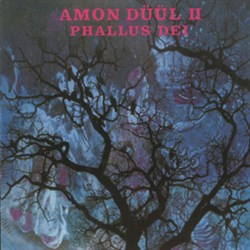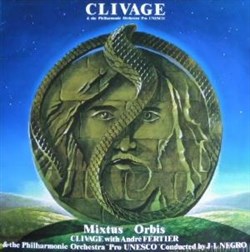
BY HASAN MURAT SÜMER (EE/IV)
hasan.sumer@ug.bilkent.edu.tr
The psychedelic rock of the 60s and 70s is most often characterized in terms of its relation to psychedelic drugs and their effects. In a more musical sense, I would contend that psychedelic sound is a sound with certain abstract characteristics that a knowledgeable listener can recognize by intuition. In a more general sense, psychedelia is an ingredient of music that is not limited to only some genres—it’s everywhere, it watches us in our sleep. In the case of the more ambitious productions of rock or folk music, this ingredient is rarely close to zero percent (the outputs of prog giants “Yes” and “Genesis” are two such rarities). In this and my next column, I’ll discuss some prime examples of works that are heavy on the psychedelia.
Phallus Dei – Amon Düül II
Krautrock is a German rock movement that emerged in the late ’60s. Its purpose was to go even beyond the hypnotic and eccentric  elements developed by psychedelic rock musicians in the United States. It ignores conventional structures and emphasizes electronic treatments and lengthy instrumental epics. Amon Düül was a student and hippie commune focused on psychedelic art that made political and social statements. Some commune musicians with more ambition formed Amon Düül II, emerged from the underground with their debut “Phallus Dei” (1969), and became pioneers of Krautrock. The music is highly psychedelic, highly experimental and highly progressive, although I believe the term “progressive” was not yet in use at the time. The musicianship is fantastic. Typically, the electric guitar, bass guitar and drums are the dominant instruments. Other instruments used are the organ, bongos, saxophone and the violin, which plays perhaps the most impressive parts. Both male and female vocals are employed; while the female vocals sound nice, the male vocals are strange and seem to have no aesthetic purpose. “Phallus Dei” is a journey with no destination: there’s a lot of hard jamming, but there are also lots of composition-centered passages. There are Eastern influences, there are tribal sounds, there is the hippie sound originating from their roots. Amon Düül II produced a title song that takes up the entire second half of the recording, which I think is a very brave move to make on a debut. The track’s lengthiness results in experiments, and the experiments generally result in intense, trippy psychedelic sound. Listen to this one at 10,000 meters of height.
elements developed by psychedelic rock musicians in the United States. It ignores conventional structures and emphasizes electronic treatments and lengthy instrumental epics. Amon Düül was a student and hippie commune focused on psychedelic art that made political and social statements. Some commune musicians with more ambition formed Amon Düül II, emerged from the underground with their debut “Phallus Dei” (1969), and became pioneers of Krautrock. The music is highly psychedelic, highly experimental and highly progressive, although I believe the term “progressive” was not yet in use at the time. The musicianship is fantastic. Typically, the electric guitar, bass guitar and drums are the dominant instruments. Other instruments used are the organ, bongos, saxophone and the violin, which plays perhaps the most impressive parts. Both male and female vocals are employed; while the female vocals sound nice, the male vocals are strange and seem to have no aesthetic purpose. “Phallus Dei” is a journey with no destination: there’s a lot of hard jamming, but there are also lots of composition-centered passages. There are Eastern influences, there are tribal sounds, there is the hippie sound originating from their roots. Amon Düül II produced a title song that takes up the entire second half of the recording, which I think is a very brave move to make on a debut. The track’s lengthiness results in experiments, and the experiments generally result in intense, trippy psychedelic sound. Listen to this one at 10,000 meters of height.
Mixtus Orbis – Andre Fertier’s Clivage
Although I have tried and failed several times to convince my fellow columnist Altuğ that this is more than just garbage, it’s actually a piece of unique beauty that reflects true talent. Indian music was a major influence for the inventors of psychedelic rock. Raga rock is a subdivision of psychedelic rock in which the Indian influence is the primary ingredient, and I’ve chosen “Mixtus Orbis” (1979) to represent it here. The whole album feels like it was composed as a soundtrack for a ’70s big-budget Indian movie, but that’s the only characteristic the four individual songs share, so I feel like I need to describe each one separately. Though the title song is the first track, I’ll save it for last. The three-minute-long “Eudjal” is a lively number, very suitable for a traditional Eastern wedding. A Jethro Tull-like flute drives the short  piece, with fast-paced tablas and repetitive brass ensemble passages in the background. When “Eudjal” finishes, the ten-minute-long “Fatoum Astris” takes its place. In your imagination, this one is playing in the background when you visit a Buddhist monastery to find the truth. The hospitable monks welcome you in order to teach you their peaceful ways, and in the end, you actually do find inner peace. A folky violin predominates, accompanied by a joyful acoustic guitar and relaxed percussion in the back. In the final minutes, the flute and bass guitar pick up some speed and provide a proper finish to this meditative piece. The album closer, the four-minute-long “Youssofia,” is a little bizarre because of some chanting vocals, but it’s impressive, with a fast-paced Eastern string instrument and a seriously crazy oboe. It reminds one of the need to expect the unexpected in life and keep your perspective dynamic. Now, let’s talk about the fifteen-minute-long title song, divided into six different movements. Psychedelia exists here in the form of a musical adventure that borrows elements from lots of different genres and mixes together an immense number of instruments. A jazzy piano and classical violin open the song, and things go smoothly for a few minutes. Then the orchestra joins in, and different instruments, including the oboe, saxophone and tabla, are introduced progressively. Somewhere in the middle and continuing through the rest of the piece, the orchestra starts to play a short rhythm repetitively in the background, accompanied by a soprano female voice, while the individual instruments go crazy in the front. At some point, all of these elements fuse with each other and the output becomes chaotic. This title song is a technical masterpiece, which starts slowly and requires more and more attention from the listener as it progresses. At some point, you’ve just got to let your consciousness die, and let the music take you anywhere it pleases. After all, that’s what psychedelia is all about.
piece, with fast-paced tablas and repetitive brass ensemble passages in the background. When “Eudjal” finishes, the ten-minute-long “Fatoum Astris” takes its place. In your imagination, this one is playing in the background when you visit a Buddhist monastery to find the truth. The hospitable monks welcome you in order to teach you their peaceful ways, and in the end, you actually do find inner peace. A folky violin predominates, accompanied by a joyful acoustic guitar and relaxed percussion in the back. In the final minutes, the flute and bass guitar pick up some speed and provide a proper finish to this meditative piece. The album closer, the four-minute-long “Youssofia,” is a little bizarre because of some chanting vocals, but it’s impressive, with a fast-paced Eastern string instrument and a seriously crazy oboe. It reminds one of the need to expect the unexpected in life and keep your perspective dynamic. Now, let’s talk about the fifteen-minute-long title song, divided into six different movements. Psychedelia exists here in the form of a musical adventure that borrows elements from lots of different genres and mixes together an immense number of instruments. A jazzy piano and classical violin open the song, and things go smoothly for a few minutes. Then the orchestra joins in, and different instruments, including the oboe, saxophone and tabla, are introduced progressively. Somewhere in the middle and continuing through the rest of the piece, the orchestra starts to play a short rhythm repetitively in the background, accompanied by a soprano female voice, while the individual instruments go crazy in the front. At some point, all of these elements fuse with each other and the output becomes chaotic. This title song is a technical masterpiece, which starts slowly and requires more and more attention from the listener as it progresses. At some point, you’ve just got to let your consciousness die, and let the music take you anywhere it pleases. After all, that’s what psychedelia is all about.
